Mark Knopfler’s “Sultans” Strat (ser.-no. #68354) is from 1961. The second red Fender Strat he played with Dire Straits (ser.no #80470) was from about the same period (apart from the question in how far it was original Fender at all). For this reason I put together a table to give you a survey about the distinctive features that are different on a 1961 Strat compared with earlier or later Strats.
| 1961 Strat | before | later | |
|---|---|---|---|
| Body wood | alder (ash for models in blonde) | light ash (swamp ash) until 1956 | heavy ash in the 70ies |
| Fingerboard | slab board made of Brazilian rosewood | one-piece maple nack until 1959 | curved rosewood venue from mid 1962 on, optional maple board in the late 60ies, one-piece maply neck available in the 70ies again |
| Pick-ups | staggered pole-pieces, formvar wire insulation, magnetic northpole on top | magnetic southpole on top in the early 50ies | enamel wire insulation from about mid 1964 on, flush polepieces from 1974 on |
| Pickguard | three layers (white/black/white) pickguard of celluloid, fixed with 11 screws, screw #3 between middle and neck pick-up | one layer plastic pickguard (or bakelite before 1957) until 1959, fixed with 8 screws (a few models with three layers and 8 screws in 1959) | screw #3 moved to middle pick-up in 1963, three layers plastic pickguard from 1965 on |
| Bridge | 6 individual bridge saddles made of bent steel, separate steel tremolo block, | same | no separated tremolo block from 19xx on, diecasted bridge saddles, |
| Laquer | thin nitro laquer, standard was three tone sunburst (yellow/red/black), many custom colours available | thin nitro laquer, standard was two tone sunburst (yellow/black) until 1958, only a few (and rare) custom colours available | glossy polyesther finish from 1968 on |
| Tuners | made by Kluson, stamped with one line with “Kluson deluxe” | same | stamped with two lines with “Kluson deluxe” from 1964 on, made by Schaller from 1968 on |
| Pick-up switch | 3-way | 3-way | 5-way from 1977 on |
| Body contours | deeply contoured - individual differences due to hand work | deeply contoured - individual differences due to hand work | becoming less contoured from the mid 60ies on |
| Stratocaster decal | gold “spaghetti logo” with two patent numbers | gold “spaghetti logo”, no patent numbers until 1960, | In late 1964 Fender changed to the fatter gold transitional logo,black logo from 1968 on three patent number 1963-1964, later 4 numbers |
| Peghead size | small | small | big head from 1966 on |
| String holders | one butterfly string holder | one round holder until 1956 | two string holders from 1974 on |
| Number plate / neck fixation | 4 screw number plate with stamped serial number | same (1954 models sometimes with serial number on tremolo plate) | stamped with big F from 1966on, three hole number plate from 1972 on |
| Serial numbers | 5 digits, ca. 50 – 80,000 range | lower numbers | higher, starting with the letter L from 1964 on, 6 digits from 1965 on |
Detail pictures
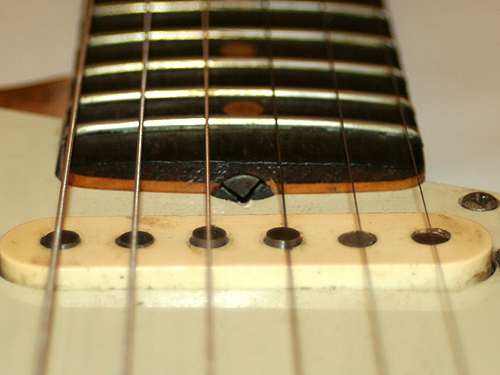
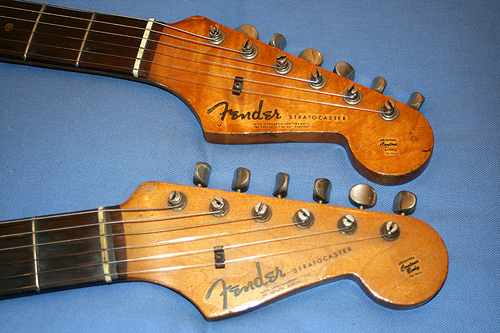
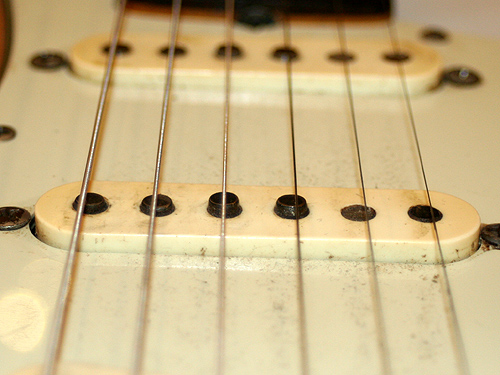
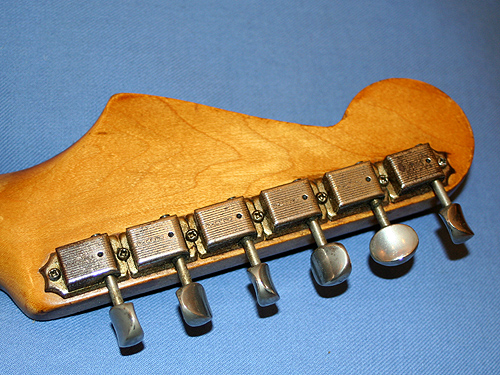
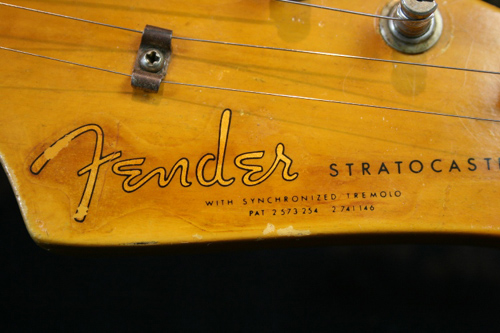
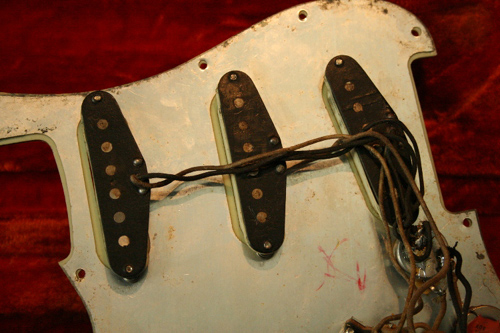

17 thoughts on “Features and specs of a ’61 Vintage Stratocaster”
Very nice and Ingo. And which was exectly the output of a ’61 strat? Because to my ears sounds like a bit down from 6 kohm. I wonder if I have right that was something like 5.8k
I have an interview where Mark says : “For the sound of Sultans, I’ve played my 61 strat, with the switch in mid-way, because it was a 3 way switch, and I believe that just after that, Fender maded strats with 5-way switch to get that sound”
Ok, I don’t want to ressurge the Sultans-PU debate, but this interview shows that Mark thought it was Sultans that gave the idea to Fender to make 5-way switchs. And according to the date (1977), I think he’s wrong, Fender had the idea a little bit before Sultans became a big hit on radio 🙂
Just a coincidence ? Or maybe Fender wanted to make avalaible the sound that was more and more used a the time (Clapton, JJ Cale, and so on)
Another remark about Headstocks : It was indeed larger from 1965 I think (Tony Joe White has one from 1965 on the cover of the album where he plays with Mark, and the headstock is a bit larger than 50 and early 60 models), but it was a “little” larger. Then, from 1968, it had the “very” large headstock (like hendrix’s “black beauty”, Gimour’s original “black strat” and blackmore’s one, etc…).But in the 80’s, the small headstock came back, as it is nowadays.
Also, about the contour body, my 2005 strat has a “original contour body” logo on the headstock. Does it mean that Fender came back with some original specs ? (the “old” bridges has came back too, from 2 years I think)
That is great Jean. I also hear Mark on an interview and he says this ’61 strat is from sultans on swing around and he says, back then you learn to adjust the little switch to stay between potisions and got this out of phase thing. To me is of course middle +bridge but with a maple neck strat. Like he has the 60’s pickups in to the maple strat. That’s that I found. I know I think exactly the tone for the sultans. Of course you must have the right tubes. Don’t forget that.
@Jeff-Anthony
All those Fender PUs should have the same number of coil turns, and thus the same DC resistance, but in fact they don’t. They are all roughly between something like 5.8 to 6.3, but these are rather individual differences and not constant for particular years.
@Jean-Francois
The 5-way switch had nothing to do with Sultans. Besides it was really no problem to get those in-between sounds with the 3-way switch, it was just more stable with the 5-way switch (in fact it was the same switch with just two more notches to make it snap into that position easier). I have 3-way switches on most of my Strats and don’t give a damn about it.
big headtsocks: all 66 Strats have the big one, most 65 the small one. To be more concrete: it seems the change was in December 65, so yes, there are a few late 65’s with the big head.
I don’t think there is a difference between the head of a 66 and a 68 or later.
The “original contour body” does not mean anything. A 74 Strat had it, too, and here the contours were heavily reduced.
@jeff-Anthpony # 3
We don’t know what kind of PUs originally were in the maple-neck Strat, but most of the time he had the loaded pickguard of the rosewood Strat on it (probably with two original ’61 PUs and a Dimarzio FS-1)
Is there a possibility to have that strat an ash body insteed of the original alder? Also those 61 pickups does they have the same materials as a 56 or 57 strat except from the slightly hotter wound?
@Ingo
I know that 3-way switch strats can play in between position (you explain me this a few years ago 🙂 )
But, I guess that Fender decided to make 5-way switch to make easier to get that sound, and probably because this kind of sound was more and more popular at that time.
And reading the Mark’s interview, it looks like HE believed that Fender’s decision was influenced by the success of Sultans.
I don’t think so, as you quote the date 1977, but who knows…
About big headstocks : maybe you’re right. I guess it’s the large and long decal “stratocaster” from 1968 on, which make me think that the headstock is larger.
@Jeff-Anthony #5
You mean Mark’s 61 strat? While theoretically a 61 can have an ash body (e.g. the blonde ones had, and generally ecverything was possible back then)Mark’s strat seems to be alder. There are only very few pictures around showing it with the bare wood finish it had before it was painted to red, but one of the pics looks very much like alder.
The PUs are really similar to those from the late 50ies.
@Jean-Francois #6
1977 is confirmed by many sources, and the success of Sultans in the US was in 1979.
The black Fender decal was introduced in 1968 and might in fact make the head shape appear different.
Starting in late 1965 CBS changed the shape of the Stratocaster headstock, the decal change came around ’68. It’s not an optical illusion, the new headstock was enormous! lol
@Ingo #7
Could you show us these pictures of the strat with the bare wood finish, or are they the ones on the “Clapham Common bandstand” article ?
Do you have more ? Do you have any color pictures ?
I would die to see Mark with his strat like this.
Many thanks
The picture in question is in the Michael Oldfield book on page 46/47 (Mark at the Hope&Anchor…). Need to scan it first.
I have the book at home, but can’t check it now.
If memory serve, I remember a pic of Mark with the rosewood strat at the end of an early chapter, but the french caption says “Mark at portobello road” or something like that. he has the same clothes as on Chorus, Rotterdam 78, or live at BBC cover.
Is it this one ? How are you sure with the date of the pic ?
The only other very early pic with a strat featuring on the book, is the one with the maple neck.
The others pics seems to be from after summer 78, so in red finish for the rosewood strat.
I have checked the book 🙂
But I didn’t find the pic you’re talking about 🙁
on page 46/47, there’s indeed a pic from “Hope&Anchor autumn 1977”, but with David ! And indeed, altough the pic is B&W, we can clearly see that his strat is bare wood finsih, but I’m not specialist to say what kind of wood it is.
But, as Mark is concerned, there’s no pic with him. I have the french edition of the book. Are the pics differents in the english edition ?
I know that the cover is different : the english edition is Mark with the schecter sunburst strat, while the french edition is Mark with the mapple red strat (I guess Paris 1979, as it looks quite the same as the ones at the end of the book)
the other early DS pic I was talking about is on page 77. Mark is with the rosewood strat, and has the same clothes as on Chorus, Rotterdam 78, or live at BBC cover.
Thers’s no caption. the “portobello road” is from the text page 76.
To me, the finish of the body looks like red on this B&W pic, but I’m not sure.
Then the French and the English version are different (not really a surprise). The picture I was talking about is from the Hope&Anchor (you can see the letters “OPE..” on the wall in the background, Mark is wearing some white shirt over a black T-shirt.
would it be possible to see this pic ?
or even all pics of the english edition ? 🙂
I hate scanning but will scan this picture a bit later.
The decal with 2 patent numbers ion the photo is not the original decal .. the originals had a comma after the first patent number – that decal has been replaced at sometime. Not unusual – many had fallen off or disintergrated within the first 5 years anyway.
This is possible. I admit I took this picture of a 61 Strat from google and did not really check originality here. So thanks for the hint.